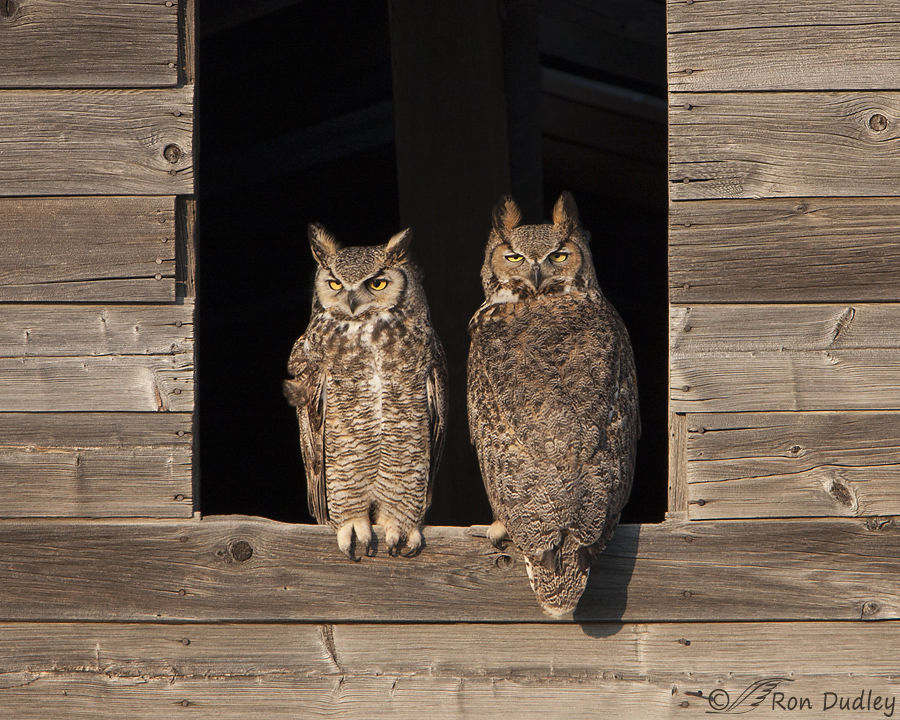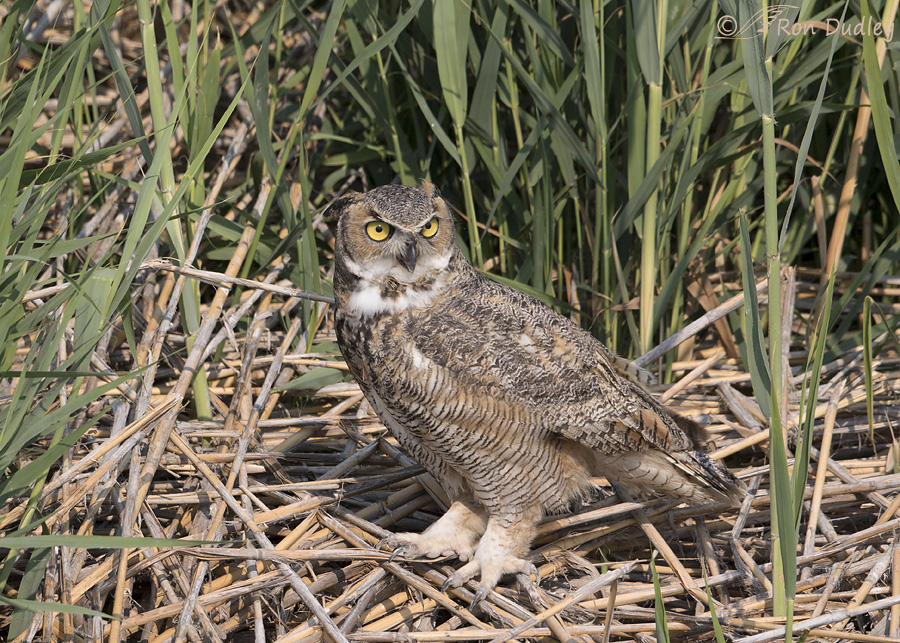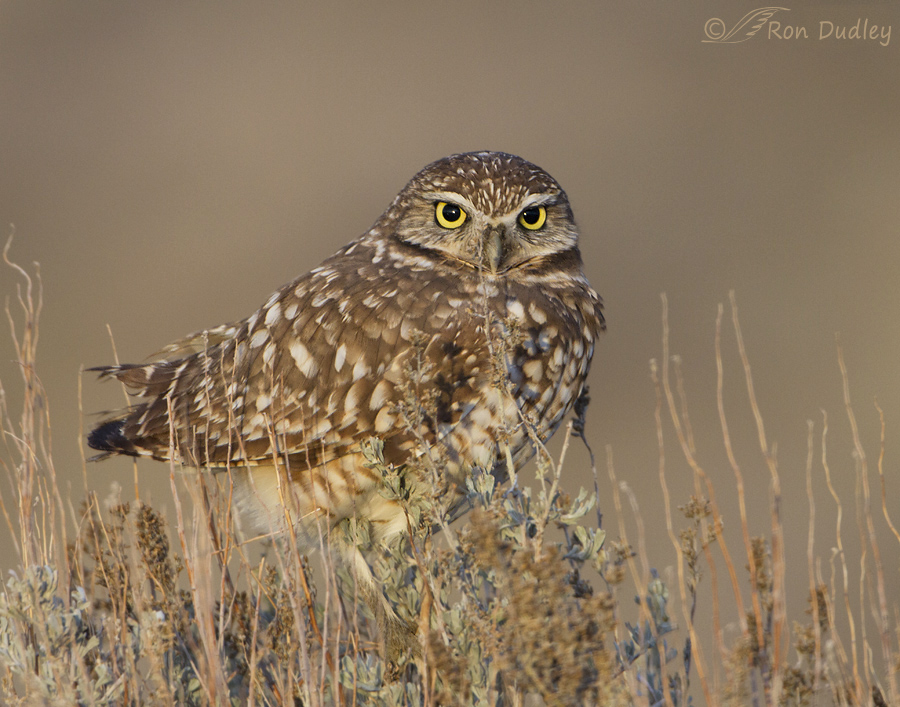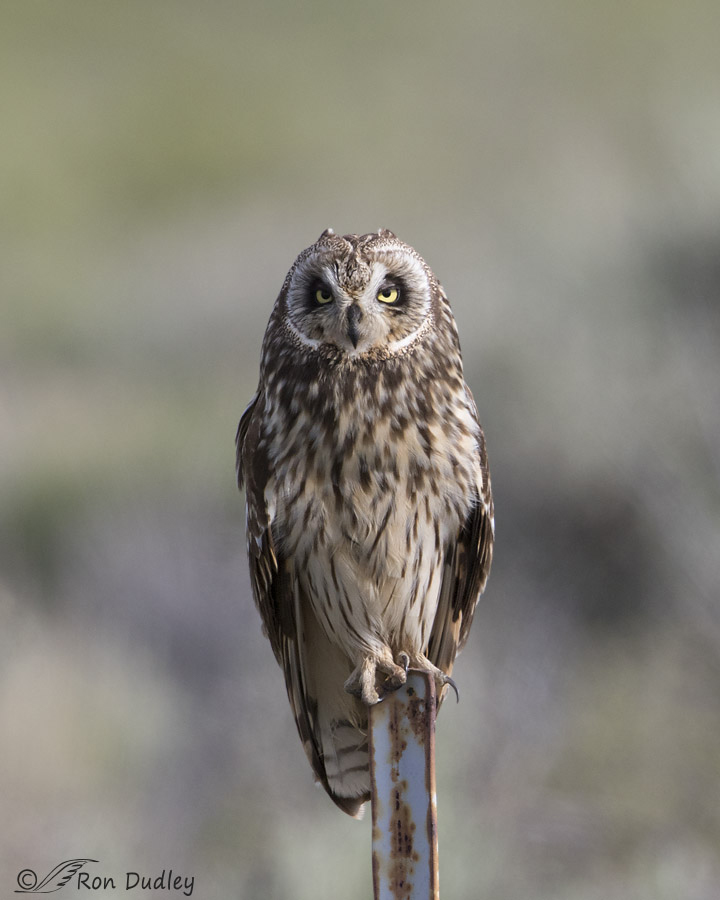Verifying the actual function(s) of some biological structures has proven to be elusive. The presence of plumicorns in owls is a case in point.
Ear tufts in owls are not ears and they have nothing to do with hearing. And they aren’t horns either. The technical term for them is plumicorns (Latin for “feather-horn”). About 50 of the 225 living owl species have plumicorns.

1/400, f/8, ISO 400, Canon 40D, Canon EF 500mm f/4L IS USM, not baited, set up or called in
When we think of plumicorns it’s probably the Great Horned Owl that first comes to mind for most of us. In this species plumicorns are quite prominent and as we can see here both sexes have them. This is a mated pair and the female is the larger bird on the right.
 1/2500, f/7.1, ISO 250, Canon 7D Mark II, Canon EF 500mm f/4L IS II USM, not baited, set up or called in
1/2500, f/7.1, ISO 250, Canon 7D Mark II, Canon EF 500mm f/4L IS II USM, not baited, set up or called in
Usually Great Horned Owl plumicorns are held erect but this bird flattened them against its head for almost the entire time I spent with it. From watching the bird carefully I’m confident that it wasn’t a reaction to my presence but I can’t explain the behavior with any confidence.

1/320, f/7.1, ISO 640, Canon 7D, Canon EF 500mm f/4L IS USM + 1.4 tc, not baited, set up or called in
Burrowing Owls are one of the many species of owls without plumicorns.

1/3200, f/6.3, ISO 800, Canon 7D Mark II, Canon EF 500mm f/4L IS II USM + 1.4 tc not baited, set up or called in
Short-eared Owls have them but they’re small (thus their common name) and usually not held erect so they’re difficult to see. This is one of the relatively few images I have of the species where they’re apparent.
But the actual function of plumicorns is yet to be verified. Several hypothesis have been proposed including the following:
- they may enhance an owl’s ability to mimic a mammal and appear more frightening to mammalian predators.
- they may aid in species recognition
- they may have a camouflage function by breaking up the owl’s outline and making it appear more like a broken branch
There are other theories too but none of them has been accepted by the scientific community so the debate continues.
If you’re curious about that debate and you’re also in an ornitho-geeky mood I suggest you read this short article from Tetrapod Zoology – “Why Do Owls Have Ear Tufts?”
And the comments are at least as enlightening as the article (and more entertaining).
Ron
Note: Owls aren’t the only birds with ear tufts. Horned Larks, Stitchbirds, Ring-necked Pheasants, Tufted Puffins, Royal Rockhoppers and several crested penguin species also have identifiable ear tufts.


Fascinating, professor.
Interesting and thanks for the new word Ron. Great Horned Owls really remind me of cats when their plumicorns are up. I was pretty sure that they only displayed them when they felt threatened. Which may indicate they are trying to imitate another animal, like a cat, to scare away threats, which is consistent (kind of..) with your first bullet point.
Western Screech Owls have them.
Boreal and N Saw Whet (both of genus Aegolius) do not have them.
Pygmy Owls do not have them.
As you point out Burrowing Owls do not have them.
The Strix genus (Barred, Great Gray, Spotted Owl) do not have them.
Very strange… a puzzle
An interesting rundown of some of the species that do and don’t have them, Ed. Thanks for providing it.
Ron,
What a look on the faces of the two owls. The eyes say it all but I am not sure what they are saying. Does the husband want to be rescued?
Stephen Clayson
He does have a bit of a browbeaten look, doesn’t he?
Thanks for teaching a new word! Didn’t realize they had an official name beyond ‘feather tufts’. So now when I get up in the morning and my hair is sticking up, can I say it’s just my plumicorns showing?
Works for me, Jeff. Although it might be a good idea if your “significant other” knows what plumicorns are first. After all, you don’t want a misunderstanding.
Plumicorns is yet another reason for this bird and word nerd to love owls. Thank you.
And, as I have often said, too many owls is barely enough. I always love to see an owl post. Thank you. And will investigate the link too.
“Bird and word nerd” has a bit of a ring to it, EC. I like it!
Love this series/discussion! When I was doing education programs, I loved showing/demonstrating how the little screech owls disappeared into the bark of a tree! It amazes folks and I gotta admit that I giggle when that happens (I’m so easily amused).
I also loved it when they’d go into the nobody-here-but-us-broken-off-branches posture, which is standing tall, feathers held close to their body with the ear tufts erect and eyes closed. Why did some owls develop plumicorns (thanks for the new vocabulary word!) and others didn’t? Got me! I’m not in charge of these things, but I’m certain there’s a good reason for it. I love the mysteries of life, too. Ain’t life grand?
Laura, I’m envious of those of you with experience with Screech Owls. I’ve rarely even seen one, even from a distance.
What’s really cool about screech owls is that they do the same threat display as a GHO, but they’re just so small it’s kinda comical. I KNOW it’s not supposed to be comical, but it is. They’ve got their wings spread out so they look like a furby and they sway back and forth, beak clacking with the message, “I’ll take you down. Don’t MAKE me go there!” Of course, they’re as dangerous as Kestrels with getting their talons in between the joints of your fingers or up underneath your fingernails. That hurts!
I just LOVE screech owls. They’re entirely too cool. But yes, I remain easily amused
I’m around owls a fair bit through rehab and education programs. It strikes me that no mention has been made of the one-up/one-down tuft position that I sometimes see in Great-horneds. To me they look pretty silly: “You just woke me up. I don’t have my tufts on straight yet.” And I’d bet photographers would just delete those shots. My vote is for camouflage- if you’ve ever seen a Screech scrunch up it’s face, get skinny, turn sideways and turn into a stick, well… but having a trait selected for one advantage does not preclude using the same trait for something else. I’d also believe that the plumicorns (thanks for the new word) express emotions to one another and to us if we’re paying attention. Owls look different when they are comfortable, when they are wary, when they are aggressive, and the horns contribute. On another subject, I’ve never known an owl to have a sense of humor. Other birds, yes, owls never. Thank you once more, Ron!
I sure wouldn’t delete “those shots”.
And your mention of the lack of a sense of humor in owls reminded me of one of my theories. It’s my belief that one of the reasons most folks love owls so much is that when they perform behaviors that look silly to us (parallaxing for example) that behavior in combination with their typically serious and even stern expressions seems so incongruous to us that we find it endearing and lovable.
What a wondeful word…plumicorn…and to think I raised one and never heard the term before…I would guess that they raise theie “horns” to look tough, but in my experience, when they’re feeling ornery, they usually
slick them down, click their beaks and hiss instead.
I like that word too, Patty. Perhaps not as a substitute for ear tufts but in addition to.
When we had that New England irruption of Snowy Owls a few years ago, I noticed many of my pictures showed tiny hornettes, even smaller than the Short-ears’s. I do wonder what they’re all about!
Thanks for the linked article – very interesting.
That’s something I wasn’t aware of in Snowy Owls, Naomi. But then I’ve never seen one in the wild.
Interesting subject. The linked article immediately brought to mind the Long-eared Owls that like to roost in a couple of specific trees in the Hueco Tanks campground. They are extremely difficult to see, even when you know where to look for them. The trees they like are Arizona White Oak (a type of Live Oak or Scrub Oak), which tend to have rather convoluted branches. I am certain that their ear tufts help them blend into those trees. For me, camouflage is the only explanation that makes any sense as to why they have the plumicorns.
Susan, seems logical that camouflage would be consistent with the fact that both sexes have them. But then you have to wonder why many other arboreal species of owls lack them.
Great Plumicorned Owl just doesn’t seem to have the same ring to it. These are fabulous shots! I especially like the first one. The male looks a little dazed — ruffled feathers on the wing, uneven pupils — and the female looks pretty irritated as if you may have interrupted some “owl shenanigans.”
These are fabulous shots! I especially like the first one. The male looks a little dazed — ruffled feathers on the wing, uneven pupils — and the female looks pretty irritated as if you may have interrupted some “owl shenanigans.”
Again, gorgeous shots, an informative post, and another fun addition to my vocabulary!
“Great Plumicorned Owl just doesn’t seem to have the same ring to it.”
Excellent (and amusing) point, Marty.
Actually the female had just landed in that auger opening and she turned her head to check me out to see if I was a potential threat before turning around and facing the same direction as the male. He’s just sleepy and bored.
It’s so cool to see her head on “swivel” too!
Hi Ron,
LOVED the discussion on the link article. Very funny. And I was compelled to read all the comments, which says something (please don’t conjecture what that might be).
BTW: I kept waiting for it, but no one mentioned phylogenetic inertia. Too bad the article was closed for comments, or I would have straightened them out.
As Richard Nixon famously said, “I am not a geek! I am not a geek!” Or something like that…

Thanks for starting my day with a few smiles.
Cheers,
Dick
Ha, that’s the first time I’ve had Tricky Dick mentioned on my blog, Dick!
Dick, if you’re a geek, I must be one too! The comments were certainly the best part, especially the argument about teleological arguments.
I wonder if the relative restraint and politeness in the comments section has something to do with the country of origin rather than it being a scientific community. Back in the days when I used to be smart, I attended some neuroscience conferences where researchers would “get into it” (e.g., “That’s the most asinine thing I’ve ever heard!”) in person.
Thanks for the post Ron. When I got to comment #9 I stopped reading. Kinda tells tells it all is is the most conclusive theory to date.
Thanks, Frank. I thought the interplay between some of the commenters was pretty interesting. So very different from the trashy comments I often see on other articles.
Forgot to add, that shot of the two Great-horns in the barn window is one of the best bird photos I have ever seen. Great shot.
Porcupine
Thank you, Porcupine. That image is one of my favorites for a variety of reasons – including how well it illustrates sexual dimorphism in GHO’s and the fact that it was taken on our Montana family farm so I love it for sentimental reasons. My grandfather and uncle built that granary in 1930. I think my dad helped a little too but he was only 10 years old at the time.
I totally agree with you. I had it on the screen, staring at it, for a good 5 minutes before I could move to the rest of the post. Kept coming back. Quite a wonderful show of the front and back of the bodies with the same head staring out on top! Quite superb.Absolutely love the whole setting as well.
Thanks very much, Gillycat.
Thank you for teaching me something new. Great photos as always.
I’m glad you enjoyed the “lesson”, Zaphir. Thanks.
Of course it’s always possible they only have ears because “chicks dig em”!
Yes, that’s one of the other theories, they could be “sexual ornaments”. But… both sexes have them.
Very nice shots Ron. Interesting topic.
Humans have to have a reason for everything, even when the meaning is genetic and has evolved over eons in a changing (over time) climate and world. A physical characteristic of an organism might be beneficial, evolve, but lose its effectiveness over time, but the characteristic remains visible. Evolution is a fascinating subject, but many times it is not necessarily hard and fast with concrete explanations, even though we humans want it to be.
Dick, vestigial structures (those that have lost their function) are typically eventually lost through evolution (because it’s a waste of energy and resources to produce something useless) so if the plumicorns are no longer useful I have to wonder why they still have them. I suppose it’s possible they’re in the process of being lost.
“I suppose it’s possible they’re in the process of being lost.” Humans in evolutionary terms are in one place, on this planet for such a short period of time to adequately know the answer unless we can deduce from fossil evidence. However, I love thinking about it and I particularly think ear tufts on the Lynx is fantastic! Probably why we have two Maine Coon Cats who both have NICE ear tufts!! LOL!
And we can add the Kaibab Squirrel to that list of mammals with ear tufts.
“Interesting” I wasn’t aware the tufts had a particular name. I was aware they aren’t ears and, at least the Great Horned Owls, do have some control over them. Interesting discussion in the link. I’m more inclined towards the camouflage camp.
I wasn’t aware the tufts had a particular name. I was aware they aren’t ears and, at least the Great Horned Owls, do have some control over them. Interesting discussion in the link. I’m more inclined towards the camouflage camp.  Beautiful pictures!
Beautiful pictures!
Who knows, Judy. Maybe it’s some combination of functions in different species – especially considering that some birds other than owls have them too.
Always love to learn more about our beloved bird. I am so glad I can go armchair birding with you when I can’t get out myself.
Thanks, Kathy. With the wind howling outside it’s likely I won’t be getting out for birds today either.
Great shots love em!! Always learning something from your post … it’s just curious that some owls have them and some don’t ..I think that fact alone eliminates most the theories???? Maybe they help to catch sound vibrations ?? But than again why some and not others…
“it’s just curious that some owls have them and some don’t”
Thanks, Marina. That question is actually discussed in the linked article/comments. And it’s interesting to note that some of the owl species with the best hearing don’t have plumicorns (Barn Owls for example).
Great shots Ron! I never knew what they were called.
Charlotte
Thanks, Charlotte. I doubt if the word “plumicorns” will ever gain wide acceptance in the non-scientific community but I thought I should throw it out there anyway.